Critical Analysis of Leadership
VerifiedAdded on 2020/02/05
|12
|2760
|58
Report
AI Summary
This report critically analyzes various leadership styles and their effectiveness in achieving high performance within organizations. It discusses the traits of effective leaders, evaluates different leadership models, and provides examples of successful leaders. The report concludes that a good leader possesses specific traits and skills that contribute significantly to organizational success.
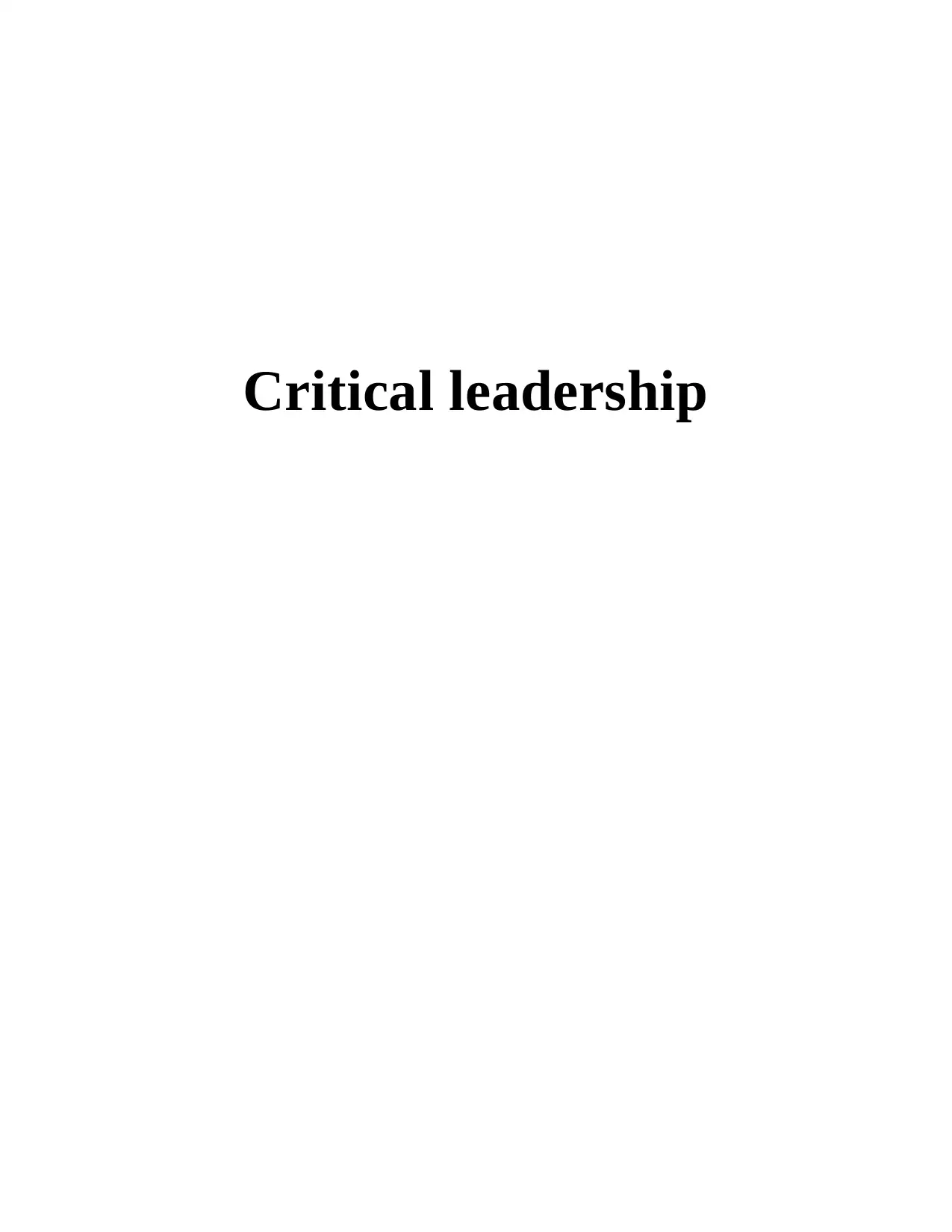
Critical leadership
Paraphrase This Document
Need a fresh take? Get an instant paraphrase of this document with our AI Paraphraser
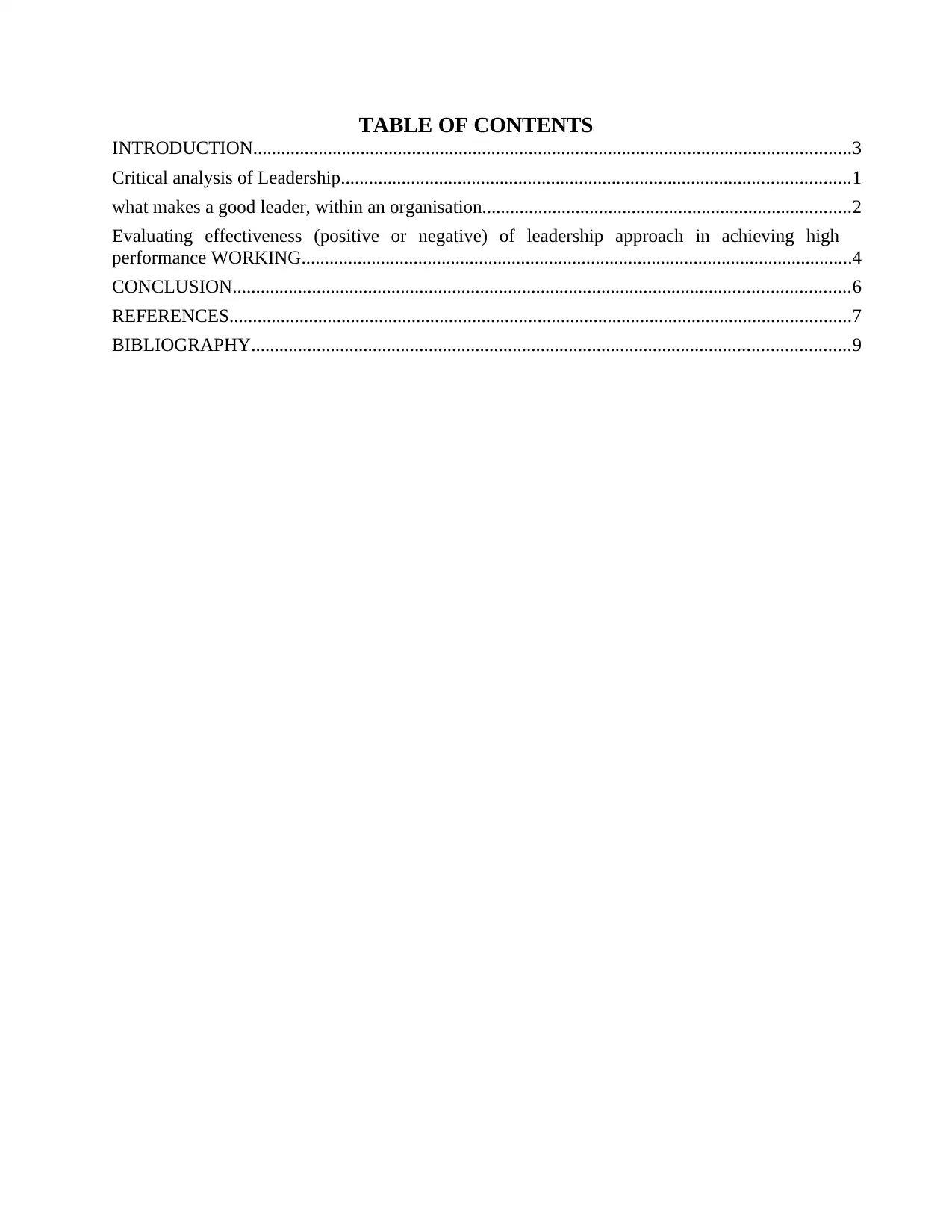
TABLE OF CONTENTS
INTRODUCTION................................................................................................................................3
Critical analysis of Leadership.............................................................................................................1
what makes a good leader, within an organisation...............................................................................2
Evaluating effectiveness (positive or negative) of leadership approach in achieving high
performance WORKING......................................................................................................................4
CONCLUSION....................................................................................................................................6
REFERENCES.....................................................................................................................................7
BIBLIOGRAPHY................................................................................................................................9
INTRODUCTION................................................................................................................................3
Critical analysis of Leadership.............................................................................................................1
what makes a good leader, within an organisation...............................................................................2
Evaluating effectiveness (positive or negative) of leadership approach in achieving high
performance WORKING......................................................................................................................4
CONCLUSION....................................................................................................................................6
REFERENCES.....................................................................................................................................7
BIBLIOGRAPHY................................................................................................................................9
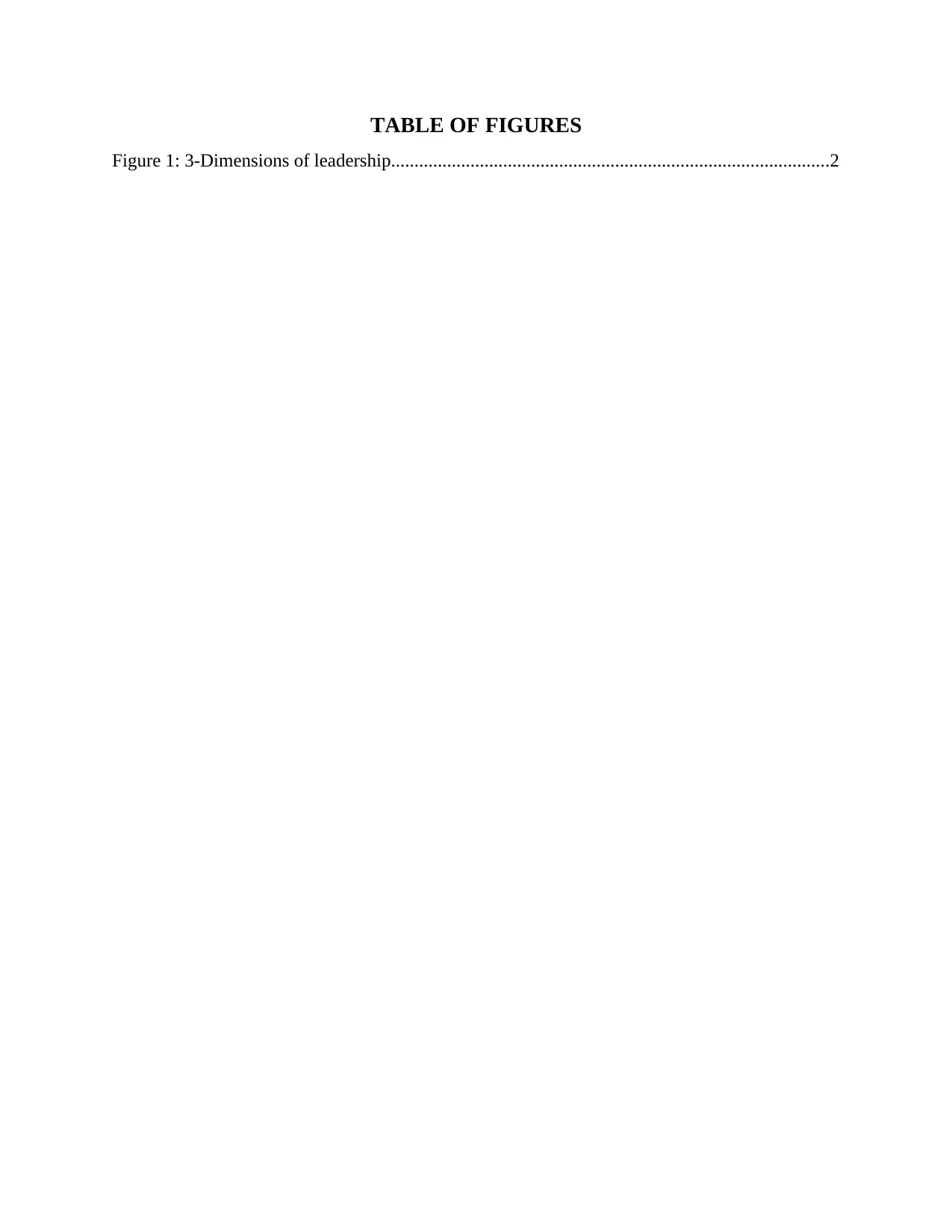
TABLE OF FIGURES
Figure 1: 3-Dimensions of leadership..............................................................................................2
Figure 1: 3-Dimensions of leadership..............................................................................................2
⊘ This is a preview!⊘
Do you want full access?
Subscribe today to unlock all pages.

Trusted by 1+ million students worldwide

INTRODUCTION
A very common saying that great leaders are born, not made has been true to some
extent. In today’s competitive business world this need to be rather broader as entrepreneurs
need to become more capable so as to lead multiple teams with allocation of various tasks. A
good leader is one who is identified with various attributes. He must possess clear vision courage
and personality in order to motivate team to thrive for organisation success (Kuhlmann, 2010).
Thence, an ethical person who shines on the ground of leadership trait is characterised as an
effective leader (Korzynski, 2013). This business report is an attempt to present the critical
analysis of leadership which has been demonstrated with the assistance of various examples of
entrepreneurs who have been succeeded so well and set very good example of good leadership
behaviour and ethical working. This ensures the application of various approaches associated
with leadership which have been suggested by different scholarly authors and writers. The
current work will show an understanding in similar regard by delivering the critical evaluation of
effectiveness various approaches used to achieve excellence working.
CRITICAL ANALYSIS OF LEADERSHIP
According to Charney (2006), the role of efficient and competent leader is to formulate
organisational aims, objectives, systematise manpower and their work to execute business plans
(Charney, 2006). If there prevails good leadership then, business environment starts feeling it
throughout and positive culture starts cultivating. In the words of Culliney (2014), good
leadership has been recognised in the form of people’s input to achieve the desired goals
(Culliney, 2014).
As stated by Northouse, (2013), leadership has been considered as a futile action which
comprises of multiple analysis and interpretation depending upon the traits, skills and abilities of
different individuals (Northouse, 2013). The most important consideration has been relied on
focusing on a particular framework that defines the role played by expected leader. The
following illustration of 3-Dimension tasks of leadership suggested by Daft (2005) will present
the leader’s functions and it’s critically analysis underneath:
Vision: This comprises of plan to ascertain ways to think for next best opportunity. It may
be in context of adopting new technology, new product, innovative aspect etc.
1
A very common saying that great leaders are born, not made has been true to some
extent. In today’s competitive business world this need to be rather broader as entrepreneurs
need to become more capable so as to lead multiple teams with allocation of various tasks. A
good leader is one who is identified with various attributes. He must possess clear vision courage
and personality in order to motivate team to thrive for organisation success (Kuhlmann, 2010).
Thence, an ethical person who shines on the ground of leadership trait is characterised as an
effective leader (Korzynski, 2013). This business report is an attempt to present the critical
analysis of leadership which has been demonstrated with the assistance of various examples of
entrepreneurs who have been succeeded so well and set very good example of good leadership
behaviour and ethical working. This ensures the application of various approaches associated
with leadership which have been suggested by different scholarly authors and writers. The
current work will show an understanding in similar regard by delivering the critical evaluation of
effectiveness various approaches used to achieve excellence working.
CRITICAL ANALYSIS OF LEADERSHIP
According to Charney (2006), the role of efficient and competent leader is to formulate
organisational aims, objectives, systematise manpower and their work to execute business plans
(Charney, 2006). If there prevails good leadership then, business environment starts feeling it
throughout and positive culture starts cultivating. In the words of Culliney (2014), good
leadership has been recognised in the form of people’s input to achieve the desired goals
(Culliney, 2014).
As stated by Northouse, (2013), leadership has been considered as a futile action which
comprises of multiple analysis and interpretation depending upon the traits, skills and abilities of
different individuals (Northouse, 2013). The most important consideration has been relied on
focusing on a particular framework that defines the role played by expected leader. The
following illustration of 3-Dimension tasks of leadership suggested by Daft (2005) will present
the leader’s functions and it’s critically analysis underneath:
Vision: This comprises of plan to ascertain ways to think for next best opportunity. It may
be in context of adopting new technology, new product, innovative aspect etc.
1
Paraphrase This Document
Need a fresh take? Get an instant paraphrase of this document with our AI Paraphraser
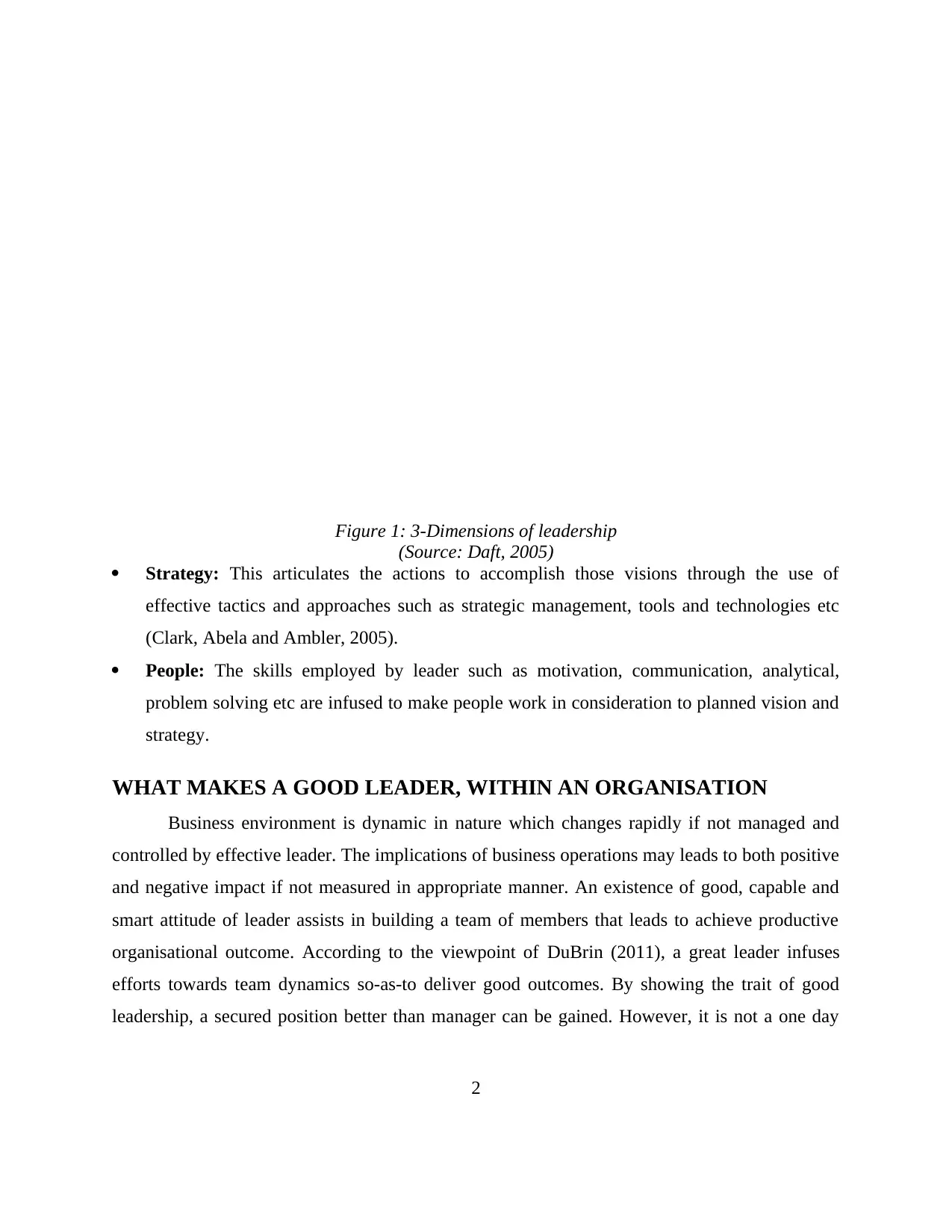
Figure 1: 3-Dimensions of leadership
(Source: Daft, 2005)
Strategy: This articulates the actions to accomplish those visions through the use of
effective tactics and approaches such as strategic management, tools and technologies etc
(Clark, Abela and Ambler, 2005).
People: The skills employed by leader such as motivation, communication, analytical,
problem solving etc are infused to make people work in consideration to planned vision and
strategy.
WHAT MAKES A GOOD LEADER, WITHIN AN ORGANISATION
Business environment is dynamic in nature which changes rapidly if not managed and
controlled by effective leader. The implications of business operations may leads to both positive
and negative impact if not measured in appropriate manner. An existence of good, capable and
smart attitude of leader assists in building a team of members that leads to achieve productive
organisational outcome. According to the viewpoint of DuBrin (2011), a great leader infuses
efforts towards team dynamics so-as-to deliver good outcomes. By showing the trait of good
leadership, a secured position better than manager can be gained. However, it is not a one day
2
(Source: Daft, 2005)
Strategy: This articulates the actions to accomplish those visions through the use of
effective tactics and approaches such as strategic management, tools and technologies etc
(Clark, Abela and Ambler, 2005).
People: The skills employed by leader such as motivation, communication, analytical,
problem solving etc are infused to make people work in consideration to planned vision and
strategy.
WHAT MAKES A GOOD LEADER, WITHIN AN ORGANISATION
Business environment is dynamic in nature which changes rapidly if not managed and
controlled by effective leader. The implications of business operations may leads to both positive
and negative impact if not measured in appropriate manner. An existence of good, capable and
smart attitude of leader assists in building a team of members that leads to achieve productive
organisational outcome. According to the viewpoint of DuBrin (2011), a great leader infuses
efforts towards team dynamics so-as-to deliver good outcomes. By showing the trait of good
leadership, a secured position better than manager can be gained. However, it is not a one day
2
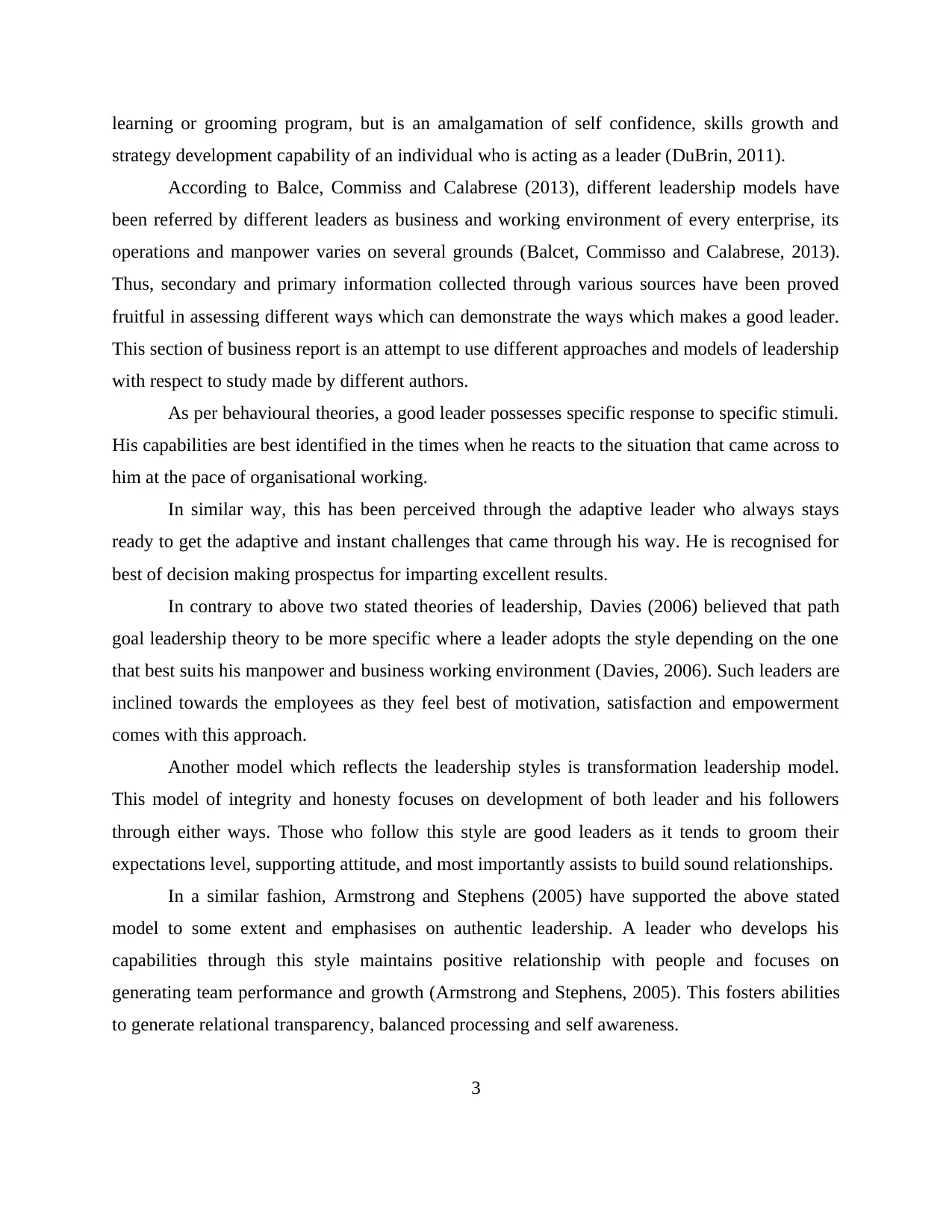
learning or grooming program, but is an amalgamation of self confidence, skills growth and
strategy development capability of an individual who is acting as a leader (DuBrin, 2011).
According to Balce, Commiss and Calabrese (2013), different leadership models have
been referred by different leaders as business and working environment of every enterprise, its
operations and manpower varies on several grounds (Balcet, Commisso and Calabrese, 2013).
Thus, secondary and primary information collected through various sources have been proved
fruitful in assessing different ways which can demonstrate the ways which makes a good leader.
This section of business report is an attempt to use different approaches and models of leadership
with respect to study made by different authors.
As per behavioural theories, a good leader possesses specific response to specific stimuli.
His capabilities are best identified in the times when he reacts to the situation that came across to
him at the pace of organisational working.
In similar way, this has been perceived through the adaptive leader who always stays
ready to get the adaptive and instant challenges that came through his way. He is recognised for
best of decision making prospectus for imparting excellent results.
In contrary to above two stated theories of leadership, Davies (2006) believed that path
goal leadership theory to be more specific where a leader adopts the style depending on the one
that best suits his manpower and business working environment (Davies, 2006). Such leaders are
inclined towards the employees as they feel best of motivation, satisfaction and empowerment
comes with this approach.
Another model which reflects the leadership styles is transformation leadership model.
This model of integrity and honesty focuses on development of both leader and his followers
through either ways. Those who follow this style are good leaders as it tends to groom their
expectations level, supporting attitude, and most importantly assists to build sound relationships.
In a similar fashion, Armstrong and Stephens (2005) have supported the above stated
model to some extent and emphasises on authentic leadership. A leader who develops his
capabilities through this style maintains positive relationship with people and focuses on
generating team performance and growth (Armstrong and Stephens, 2005). This fosters abilities
to generate relational transparency, balanced processing and self awareness.
3
strategy development capability of an individual who is acting as a leader (DuBrin, 2011).
According to Balce, Commiss and Calabrese (2013), different leadership models have
been referred by different leaders as business and working environment of every enterprise, its
operations and manpower varies on several grounds (Balcet, Commisso and Calabrese, 2013).
Thus, secondary and primary information collected through various sources have been proved
fruitful in assessing different ways which can demonstrate the ways which makes a good leader.
This section of business report is an attempt to use different approaches and models of leadership
with respect to study made by different authors.
As per behavioural theories, a good leader possesses specific response to specific stimuli.
His capabilities are best identified in the times when he reacts to the situation that came across to
him at the pace of organisational working.
In similar way, this has been perceived through the adaptive leader who always stays
ready to get the adaptive and instant challenges that came through his way. He is recognised for
best of decision making prospectus for imparting excellent results.
In contrary to above two stated theories of leadership, Davies (2006) believed that path
goal leadership theory to be more specific where a leader adopts the style depending on the one
that best suits his manpower and business working environment (Davies, 2006). Such leaders are
inclined towards the employees as they feel best of motivation, satisfaction and empowerment
comes with this approach.
Another model which reflects the leadership styles is transformation leadership model.
This model of integrity and honesty focuses on development of both leader and his followers
through either ways. Those who follow this style are good leaders as it tends to groom their
expectations level, supporting attitude, and most importantly assists to build sound relationships.
In a similar fashion, Armstrong and Stephens (2005) have supported the above stated
model to some extent and emphasises on authentic leadership. A leader who develops his
capabilities through this style maintains positive relationship with people and focuses on
generating team performance and growth (Armstrong and Stephens, 2005). This fosters abilities
to generate relational transparency, balanced processing and self awareness.
3
⊘ This is a preview!⊘
Do you want full access?
Subscribe today to unlock all pages.

Trusted by 1+ million students worldwide
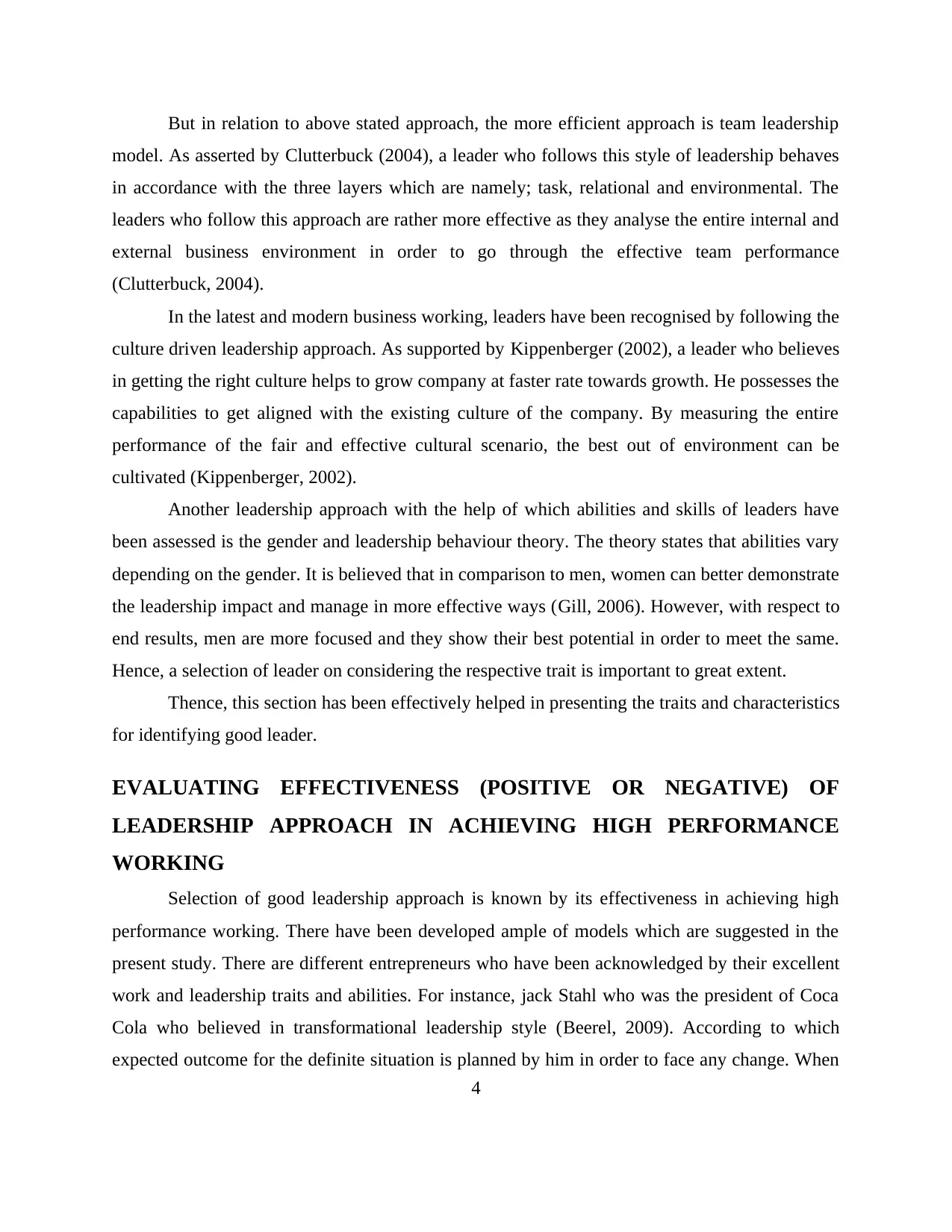
But in relation to above stated approach, the more efficient approach is team leadership
model. As asserted by Clutterbuck (2004), a leader who follows this style of leadership behaves
in accordance with the three layers which are namely; task, relational and environmental. The
leaders who follow this approach are rather more effective as they analyse the entire internal and
external business environment in order to go through the effective team performance
(Clutterbuck, 2004).
In the latest and modern business working, leaders have been recognised by following the
culture driven leadership approach. As supported by Kippenberger (2002), a leader who believes
in getting the right culture helps to grow company at faster rate towards growth. He possesses the
capabilities to get aligned with the existing culture of the company. By measuring the entire
performance of the fair and effective cultural scenario, the best out of environment can be
cultivated (Kippenberger, 2002).
Another leadership approach with the help of which abilities and skills of leaders have
been assessed is the gender and leadership behaviour theory. The theory states that abilities vary
depending on the gender. It is believed that in comparison to men, women can better demonstrate
the leadership impact and manage in more effective ways (Gill, 2006). However, with respect to
end results, men are more focused and they show their best potential in order to meet the same.
Hence, a selection of leader on considering the respective trait is important to great extent.
Thence, this section has been effectively helped in presenting the traits and characteristics
for identifying good leader.
EVALUATING EFFECTIVENESS (POSITIVE OR NEGATIVE) OF
LEADERSHIP APPROACH IN ACHIEVING HIGH PERFORMANCE
WORKING
Selection of good leadership approach is known by its effectiveness in achieving high
performance working. There have been developed ample of models which are suggested in the
present study. There are different entrepreneurs who have been acknowledged by their excellent
work and leadership traits and abilities. For instance, jack Stahl who was the president of Coca
Cola who believed in transformational leadership style (Beerel, 2009). According to which
expected outcome for the definite situation is planned by him in order to face any change. When
4
model. As asserted by Clutterbuck (2004), a leader who follows this style of leadership behaves
in accordance with the three layers which are namely; task, relational and environmental. The
leaders who follow this approach are rather more effective as they analyse the entire internal and
external business environment in order to go through the effective team performance
(Clutterbuck, 2004).
In the latest and modern business working, leaders have been recognised by following the
culture driven leadership approach. As supported by Kippenberger (2002), a leader who believes
in getting the right culture helps to grow company at faster rate towards growth. He possesses the
capabilities to get aligned with the existing culture of the company. By measuring the entire
performance of the fair and effective cultural scenario, the best out of environment can be
cultivated (Kippenberger, 2002).
Another leadership approach with the help of which abilities and skills of leaders have
been assessed is the gender and leadership behaviour theory. The theory states that abilities vary
depending on the gender. It is believed that in comparison to men, women can better demonstrate
the leadership impact and manage in more effective ways (Gill, 2006). However, with respect to
end results, men are more focused and they show their best potential in order to meet the same.
Hence, a selection of leader on considering the respective trait is important to great extent.
Thence, this section has been effectively helped in presenting the traits and characteristics
for identifying good leader.
EVALUATING EFFECTIVENESS (POSITIVE OR NEGATIVE) OF
LEADERSHIP APPROACH IN ACHIEVING HIGH PERFORMANCE
WORKING
Selection of good leadership approach is known by its effectiveness in achieving high
performance working. There have been developed ample of models which are suggested in the
present study. There are different entrepreneurs who have been acknowledged by their excellent
work and leadership traits and abilities. For instance, jack Stahl who was the president of Coca
Cola who believed in transformational leadership style (Beerel, 2009). According to which
expected outcome for the definite situation is planned by him in order to face any change. When
4
Paraphrase This Document
Need a fresh take? Get an instant paraphrase of this document with our AI Paraphraser

he was delegated any work by his senior, he infuses his entire efforts in team planning and
delegate work but shows his complete support in achieving them towards attainment.
Another example of leadership was set by Bill Gates who was the founder of Microsoft.
He used participative style of leadership where at times of stiff competition; he shows Gate’s
leadership skills. With his power of innovation and empowerment, he was successful in
connecting people through process and technology. This example shows the way through which
Bill Gats have been successful and effective in achieving the high performance.
Another example which shows the effectiveness of high level of performance has been
reflected through the Margaret Thatcher. In UK, he contributed his efforts in developing London
a hub of investments banks. Beside tough and challenging market competition, he believed in
working and showing his leadership through the competition environment in order to gain the
right situational leadership (Berke, Kossler and Wakefield, 2008). He uses Diamond’s approach
of leadership where he has been successful in combining the responsibilities with the tough risks.
In order to present the effectiveness of above discussed approaches, there is need to
analyse their positive and negative facets. Since, every leader who has followed his own
selection have been successful, but it vary on the basis of extent to which that outcome is
measured. Behavioural theory is one such aspect where stimuli contributes effective role in
assessing the reaction on the basis of situation (Clark, Abela and Ambler, 2005). The positive
aspect is that to tend to detect the behaviour and attitude of the leader. But it all depends on
whether the style chosen is autocratic or democratic. As at times of prior one, behaviour in
advertise manner may hamper the employee if too harsh attitude is shown to them. However, it
tends to be effective it they are handled properly and feel motivated and valued.
By measuring the effectiveness of transformational leadership, it has been assessed that
positive aspect of honesty and integrity is one which is achieved through the use of this style of
leadership. However, certain recent scandals and fraud are the evidence of companies whose
leadership styles are proving such worth and effective in leading wit the change. Hence this
proves to be ineffective at times.
Authentic leadership approach proves appropriate when suitable result for the analysis is
procured by the leader with respect to all three stated layers namely; task, relational and
5
delegate work but shows his complete support in achieving them towards attainment.
Another example of leadership was set by Bill Gates who was the founder of Microsoft.
He used participative style of leadership where at times of stiff competition; he shows Gate’s
leadership skills. With his power of innovation and empowerment, he was successful in
connecting people through process and technology. This example shows the way through which
Bill Gats have been successful and effective in achieving the high performance.
Another example which shows the effectiveness of high level of performance has been
reflected through the Margaret Thatcher. In UK, he contributed his efforts in developing London
a hub of investments banks. Beside tough and challenging market competition, he believed in
working and showing his leadership through the competition environment in order to gain the
right situational leadership (Berke, Kossler and Wakefield, 2008). He uses Diamond’s approach
of leadership where he has been successful in combining the responsibilities with the tough risks.
In order to present the effectiveness of above discussed approaches, there is need to
analyse their positive and negative facets. Since, every leader who has followed his own
selection have been successful, but it vary on the basis of extent to which that outcome is
measured. Behavioural theory is one such aspect where stimuli contributes effective role in
assessing the reaction on the basis of situation (Clark, Abela and Ambler, 2005). The positive
aspect is that to tend to detect the behaviour and attitude of the leader. But it all depends on
whether the style chosen is autocratic or democratic. As at times of prior one, behaviour in
advertise manner may hamper the employee if too harsh attitude is shown to them. However, it
tends to be effective it they are handled properly and feel motivated and valued.
By measuring the effectiveness of transformational leadership, it has been assessed that
positive aspect of honesty and integrity is one which is achieved through the use of this style of
leadership. However, certain recent scandals and fraud are the evidence of companies whose
leadership styles are proving such worth and effective in leading wit the change. Hence this
proves to be ineffective at times.
Authentic leadership approach proves appropriate when suitable result for the analysis is
procured by the leader with respect to all three stated layers namely; task, relational and
5
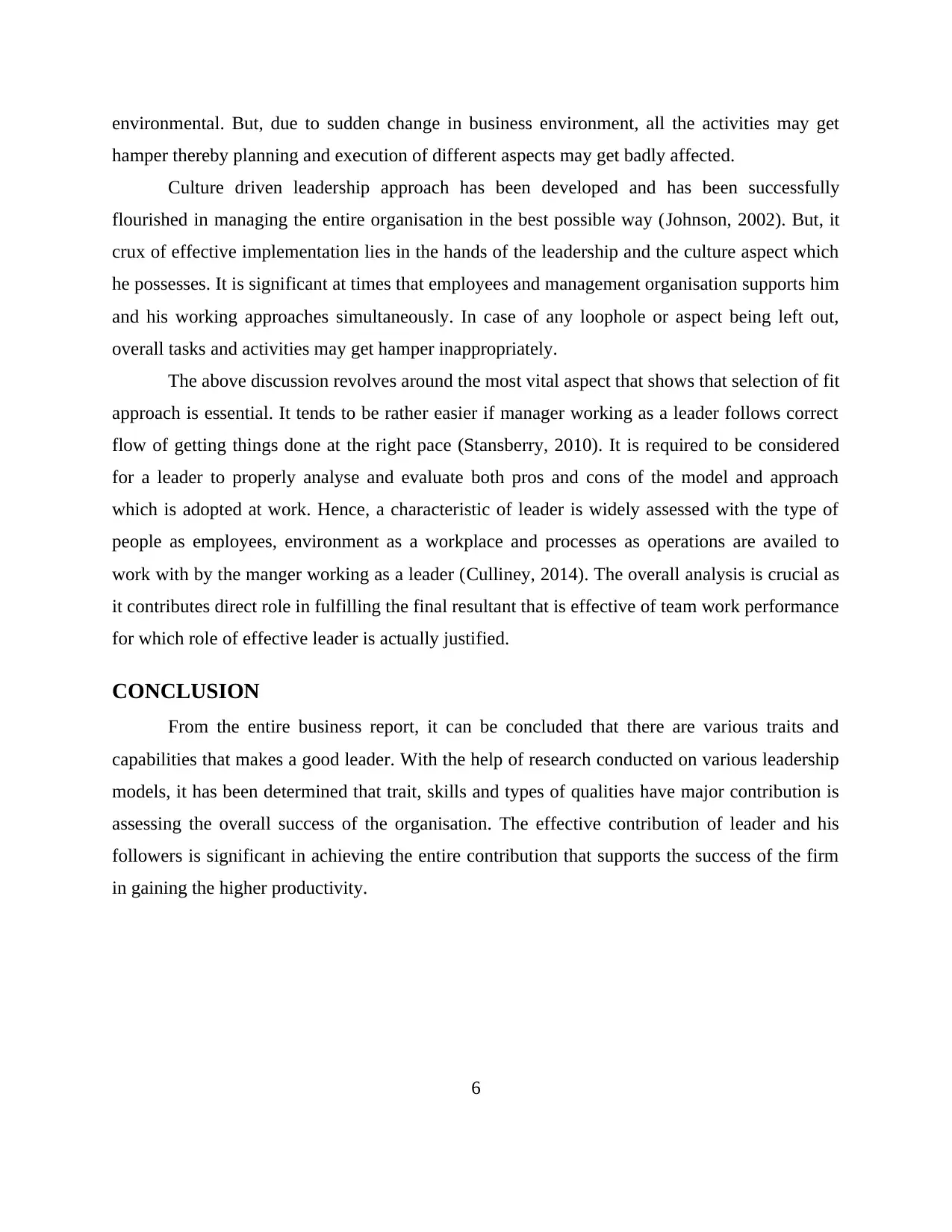
environmental. But, due to sudden change in business environment, all the activities may get
hamper thereby planning and execution of different aspects may get badly affected.
Culture driven leadership approach has been developed and has been successfully
flourished in managing the entire organisation in the best possible way (Johnson, 2002). But, it
crux of effective implementation lies in the hands of the leadership and the culture aspect which
he possesses. It is significant at times that employees and management organisation supports him
and his working approaches simultaneously. In case of any loophole or aspect being left out,
overall tasks and activities may get hamper inappropriately.
The above discussion revolves around the most vital aspect that shows that selection of fit
approach is essential. It tends to be rather easier if manager working as a leader follows correct
flow of getting things done at the right pace (Stansberry, 2010). It is required to be considered
for a leader to properly analyse and evaluate both pros and cons of the model and approach
which is adopted at work. Hence, a characteristic of leader is widely assessed with the type of
people as employees, environment as a workplace and processes as operations are availed to
work with by the manger working as a leader (Culliney, 2014). The overall analysis is crucial as
it contributes direct role in fulfilling the final resultant that is effective of team work performance
for which role of effective leader is actually justified.
CONCLUSION
From the entire business report, it can be concluded that there are various traits and
capabilities that makes a good leader. With the help of research conducted on various leadership
models, it has been determined that trait, skills and types of qualities have major contribution is
assessing the overall success of the organisation. The effective contribution of leader and his
followers is significant in achieving the entire contribution that supports the success of the firm
in gaining the higher productivity.
6
hamper thereby planning and execution of different aspects may get badly affected.
Culture driven leadership approach has been developed and has been successfully
flourished in managing the entire organisation in the best possible way (Johnson, 2002). But, it
crux of effective implementation lies in the hands of the leadership and the culture aspect which
he possesses. It is significant at times that employees and management organisation supports him
and his working approaches simultaneously. In case of any loophole or aspect being left out,
overall tasks and activities may get hamper inappropriately.
The above discussion revolves around the most vital aspect that shows that selection of fit
approach is essential. It tends to be rather easier if manager working as a leader follows correct
flow of getting things done at the right pace (Stansberry, 2010). It is required to be considered
for a leader to properly analyse and evaluate both pros and cons of the model and approach
which is adopted at work. Hence, a characteristic of leader is widely assessed with the type of
people as employees, environment as a workplace and processes as operations are availed to
work with by the manger working as a leader (Culliney, 2014). The overall analysis is crucial as
it contributes direct role in fulfilling the final resultant that is effective of team work performance
for which role of effective leader is actually justified.
CONCLUSION
From the entire business report, it can be concluded that there are various traits and
capabilities that makes a good leader. With the help of research conducted on various leadership
models, it has been determined that trait, skills and types of qualities have major contribution is
assessing the overall success of the organisation. The effective contribution of leader and his
followers is significant in achieving the entire contribution that supports the success of the firm
in gaining the higher productivity.
6
⊘ This is a preview!⊘
Do you want full access?
Subscribe today to unlock all pages.

Trusted by 1+ million students worldwide
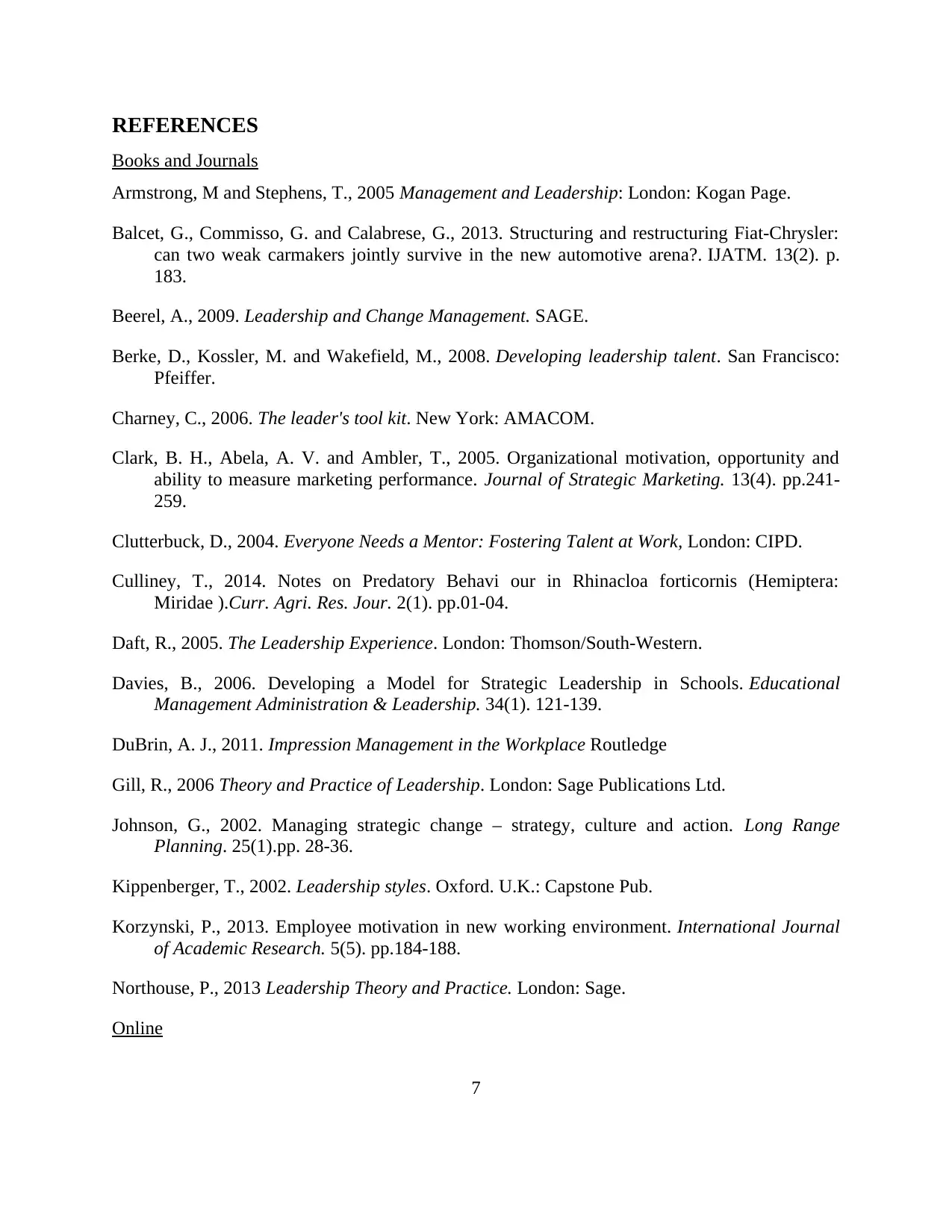
REFERENCES
Books and Journals
Armstrong, M and Stephens, T., 2005 Management and Leadership: London: Kogan Page.
Balcet, G., Commisso, G. and Calabrese, G., 2013. Structuring and restructuring Fiat-Chrysler:
can two weak carmakers jointly survive in the new automotive arena?. IJATM. 13(2). p.
183.
Beerel, A., 2009. Leadership and Change Management. SAGE.
Berke, D., Kossler, M. and Wakefield, M., 2008. Developing leadership talent. San Francisco:
Pfeiffer.
Charney, C., 2006. The leader's tool kit. New York: AMACOM.
Clark, B. H., Abela, A. V. and Ambler, T., 2005. Organizational motivation, opportunity and
ability to measure marketing performance. Journal of Strategic Marketing. 13(4). pp.241-
259.
Clutterbuck, D., 2004. Everyone Needs a Mentor: Fostering Talent at Work, London: CIPD.
Culliney, T., 2014. Notes on Predatory Behavi our in Rhinacloa forticornis (Hemiptera:
Miridae ).Curr. Agri. Res. Jour. 2(1). pp.01-04.
Daft, R., 2005. The Leadership Experience. London: Thomson/South-Western.
Davies, B., 2006. Developing a Model for Strategic Leadership in Schools. Educational
Management Administration & Leadership. 34(1). 121-139.
DuBrin, A. J., 2011. Impression Management in the Workplace Routledge
Gill, R., 2006 Theory and Practice of Leadership. London: Sage Publications Ltd.
Johnson, G., 2002. Managing strategic change – strategy, culture and action. Long Range
Planning. 25(1).pp. 28-36.
Kippenberger, T., 2002. Leadership styles. Oxford. U.K.: Capstone Pub.
Korzynski, P., 2013. Employee motivation in new working environment. International Journal
of Academic Research. 5(5). pp.184-188.
Northouse, P., 2013 Leadership Theory and Practice. London: Sage.
Online
7
Books and Journals
Armstrong, M and Stephens, T., 2005 Management and Leadership: London: Kogan Page.
Balcet, G., Commisso, G. and Calabrese, G., 2013. Structuring and restructuring Fiat-Chrysler:
can two weak carmakers jointly survive in the new automotive arena?. IJATM. 13(2). p.
183.
Beerel, A., 2009. Leadership and Change Management. SAGE.
Berke, D., Kossler, M. and Wakefield, M., 2008. Developing leadership talent. San Francisco:
Pfeiffer.
Charney, C., 2006. The leader's tool kit. New York: AMACOM.
Clark, B. H., Abela, A. V. and Ambler, T., 2005. Organizational motivation, opportunity and
ability to measure marketing performance. Journal of Strategic Marketing. 13(4). pp.241-
259.
Clutterbuck, D., 2004. Everyone Needs a Mentor: Fostering Talent at Work, London: CIPD.
Culliney, T., 2014. Notes on Predatory Behavi our in Rhinacloa forticornis (Hemiptera:
Miridae ).Curr. Agri. Res. Jour. 2(1). pp.01-04.
Daft, R., 2005. The Leadership Experience. London: Thomson/South-Western.
Davies, B., 2006. Developing a Model for Strategic Leadership in Schools. Educational
Management Administration & Leadership. 34(1). 121-139.
DuBrin, A. J., 2011. Impression Management in the Workplace Routledge
Gill, R., 2006 Theory and Practice of Leadership. London: Sage Publications Ltd.
Johnson, G., 2002. Managing strategic change – strategy, culture and action. Long Range
Planning. 25(1).pp. 28-36.
Kippenberger, T., 2002. Leadership styles. Oxford. U.K.: Capstone Pub.
Korzynski, P., 2013. Employee motivation in new working environment. International Journal
of Academic Research. 5(5). pp.184-188.
Northouse, P., 2013 Leadership Theory and Practice. London: Sage.
Online
7
Paraphrase This Document
Need a fresh take? Get an instant paraphrase of this document with our AI Paraphraser
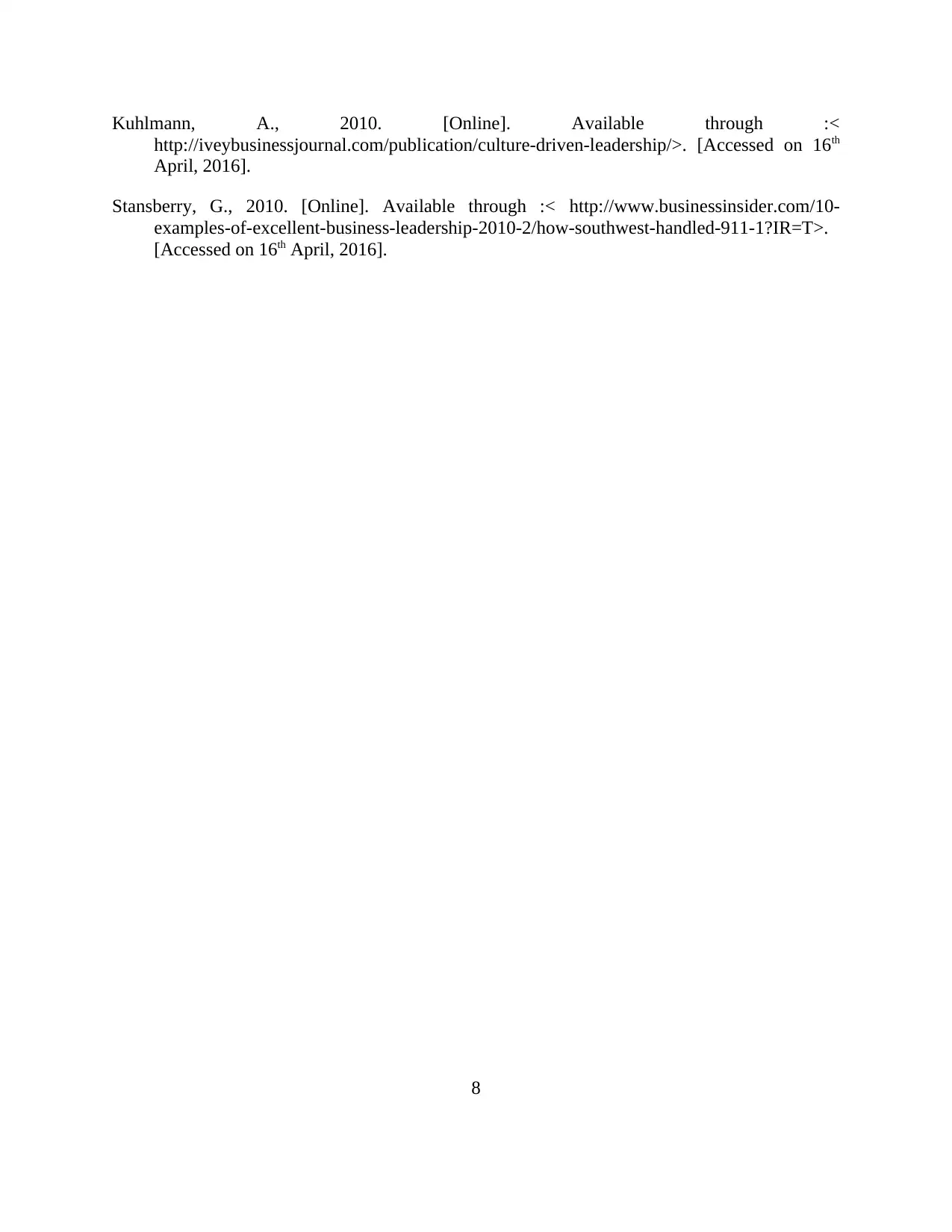
Kuhlmann, A., 2010. [Online]. Available through :<
http://iveybusinessjournal.com/publication/culture-driven-leadership/>. [Accessed on 16th
April, 2016].
Stansberry, G., 2010. [Online]. Available through :< http://www.businessinsider.com/10-
examples-of-excellent-business-leadership-2010-2/how-southwest-handled-911-1?IR=T>.
[Accessed on 16th April, 2016].
8
http://iveybusinessjournal.com/publication/culture-driven-leadership/>. [Accessed on 16th
April, 2016].
Stansberry, G., 2010. [Online]. Available through :< http://www.businessinsider.com/10-
examples-of-excellent-business-leadership-2010-2/how-southwest-handled-911-1?IR=T>.
[Accessed on 16th April, 2016].
8
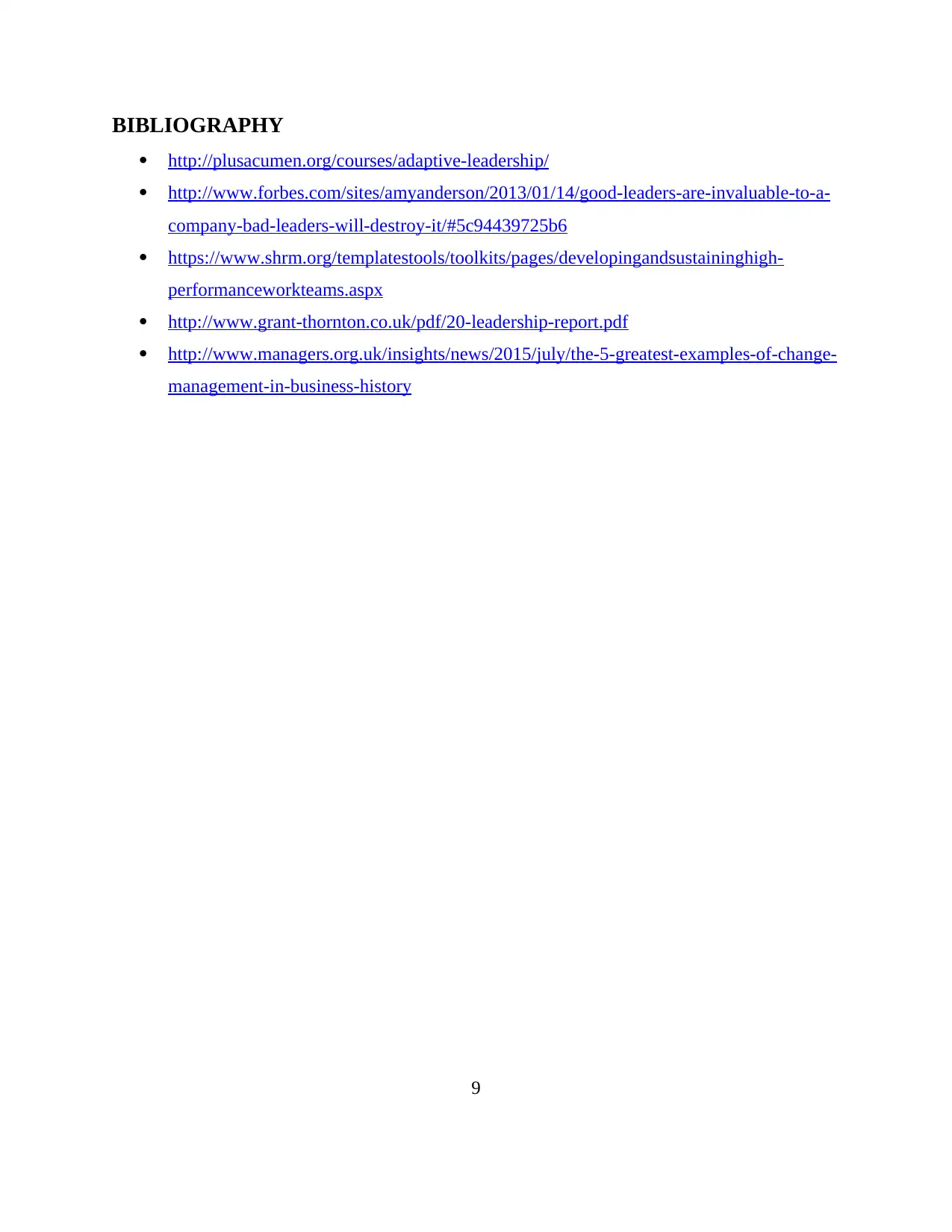
BIBLIOGRAPHY
http://plusacumen.org/courses/adaptive-leadership/
http://www.forbes.com/sites/amyanderson/2013/01/14/good-leaders-are-invaluable-to-a-
company-bad-leaders-will-destroy-it/#5c94439725b6
https://www.shrm.org/templatestools/toolkits/pages/developingandsustaininghigh-
performanceworkteams.aspx
http://www.grant-thornton.co.uk/pdf/20-leadership-report.pdf
http://www.managers.org.uk/insights/news/2015/july/the-5-greatest-examples-of-change-
management-in-business-history
9
http://plusacumen.org/courses/adaptive-leadership/
http://www.forbes.com/sites/amyanderson/2013/01/14/good-leaders-are-invaluable-to-a-
company-bad-leaders-will-destroy-it/#5c94439725b6
https://www.shrm.org/templatestools/toolkits/pages/developingandsustaininghigh-
performanceworkteams.aspx
http://www.grant-thornton.co.uk/pdf/20-leadership-report.pdf
http://www.managers.org.uk/insights/news/2015/july/the-5-greatest-examples-of-change-
management-in-business-history
9
⊘ This is a preview!⊘
Do you want full access?
Subscribe today to unlock all pages.

Trusted by 1+ million students worldwide
1 out of 12
Related Documents
Your All-in-One AI-Powered Toolkit for Academic Success.
+13062052269
info@desklib.com
Available 24*7 on WhatsApp / Email
![[object Object]](/_next/static/media/star-bottom.7253800d.svg)
Unlock your academic potential
Copyright © 2020–2026 A2Z Services. All Rights Reserved. Developed and managed by ZUCOL.





